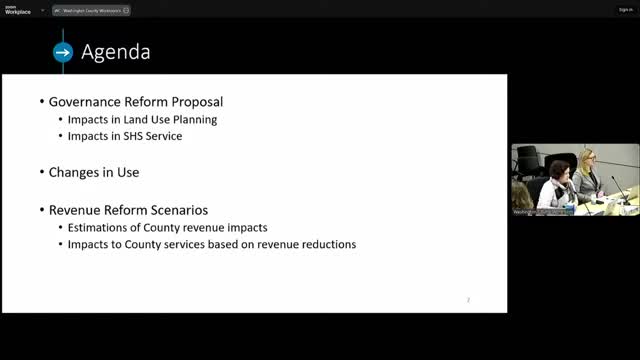Washington County outlines ambitious plan to combat homelessness
November 12, 2024 | Washington County, Oregon
This article was created by AI summarizing key points discussed. AI makes mistakes, so for full details and context, please refer to the video of the full meeting. Please report any errors so we can fix them. Report an error »

During a recent government meeting, officials discussed the ongoing reform of the FHS measure aimed at addressing homelessness in the Metro region. The meeting highlighted the progress made since the ballot measure's passage, which promised to make homelessness rare, brief, and non-reoccurring.
Key points included the identification of two target populations: Population A, consisting of chronically homeless individuals with significant barriers to housing, and Population B, aimed at preventing individuals from becoming chronically homeless. Initially, the plan allocated 75% of funds to support Population A and 25% to Population B, with ambitious goals of achieving 5,000 permanent supportive housing placements and serving 10,000 households with rent assistance and services.
Washington County is expected to contribute approximately one-third of the regional goals. Officials noted that they are currently in the fourth year of implementation, emphasizing the significant strides made in creating a sustainable system of care. They acknowledged the challenges ahead, particularly in maintaining capacity and addressing potential reductions in services.
The meeting also included a review of the regional approach to homelessness, showcasing investments in various housing solutions, including pod villages, transitional housing, and new shelters. Officials stressed the importance of regional coordination and the need for tough decisions as they navigate the complexities of the homelessness crisis.
Overall, the discussions underscored a commitment to continue refining strategies and ensuring that the needs of both populations are met effectively as the initiative progresses.
Key points included the identification of two target populations: Population A, consisting of chronically homeless individuals with significant barriers to housing, and Population B, aimed at preventing individuals from becoming chronically homeless. Initially, the plan allocated 75% of funds to support Population A and 25% to Population B, with ambitious goals of achieving 5,000 permanent supportive housing placements and serving 10,000 households with rent assistance and services.
Washington County is expected to contribute approximately one-third of the regional goals. Officials noted that they are currently in the fourth year of implementation, emphasizing the significant strides made in creating a sustainable system of care. They acknowledged the challenges ahead, particularly in maintaining capacity and addressing potential reductions in services.
The meeting also included a review of the regional approach to homelessness, showcasing investments in various housing solutions, including pod villages, transitional housing, and new shelters. Officials stressed the importance of regional coordination and the need for tough decisions as they navigate the complexities of the homelessness crisis.
Overall, the discussions underscored a commitment to continue refining strategies and ensuring that the needs of both populations are met effectively as the initiative progresses.
View full meeting
This article is based on a recent meeting—watch the full video and explore the complete transcript for deeper insights into the discussion.
View full meeting
